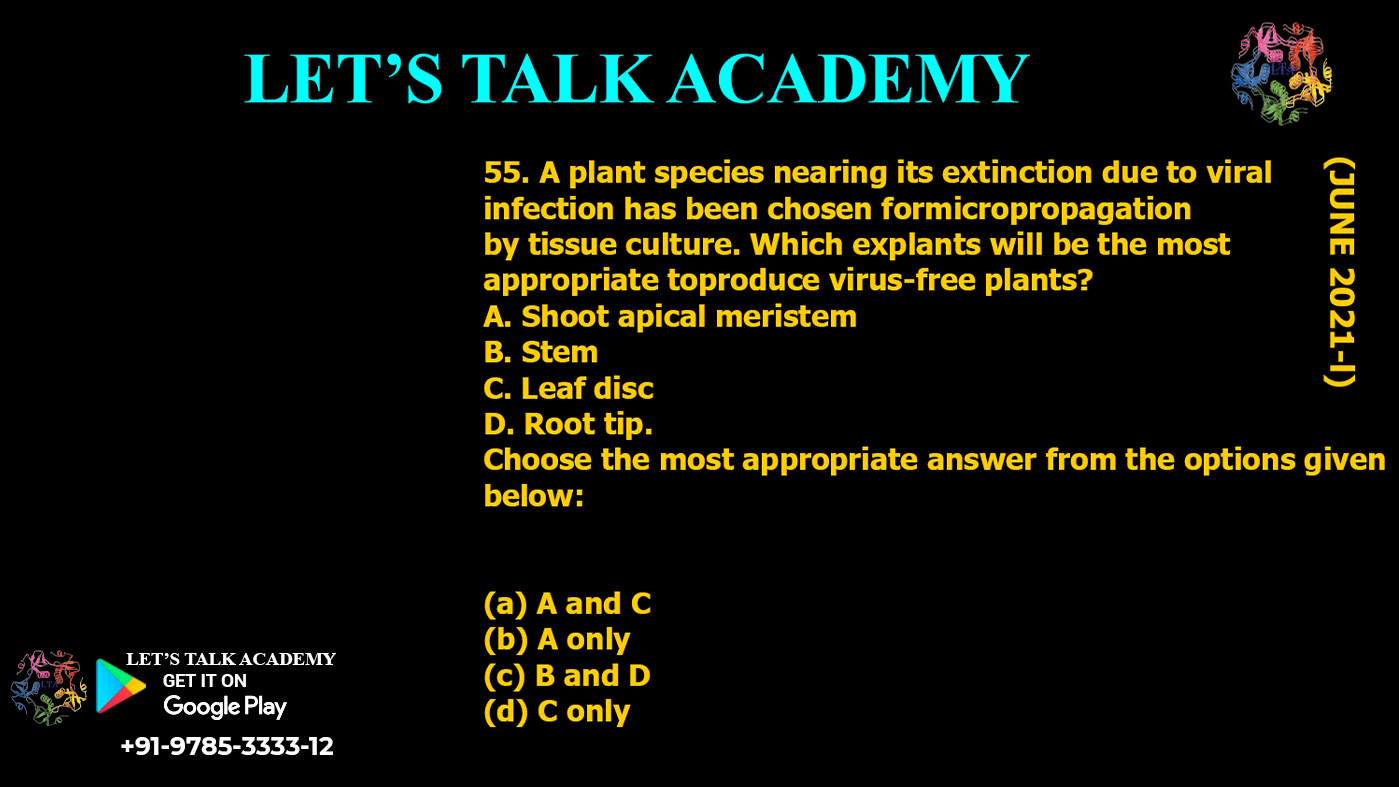55. A plant species nearing its extinction due to viral infection has been chosen formicropropagation
by tissue culture. Which explants will be the most appropriate toproduce virus-free plants?
A. Shoot apical meristem
B. Stem
C. Leaf disc
D. Root tip.
Choose the most appropriate answer from the options given below:
(a) A and C
(b) A only
(c) B and D
(d) C only
Introduction
Micropropagation through tissue culture is an effective method for multiplying plants, especially when dealing with species facing extinction due to diseases like viral infections. One of the primary concerns during the process is ensuring that the plants produced are virus-free. This requires selecting the right explants (plant tissues or organs used for culturing) that are less likely to carry the viral infection.
In this article, we will discuss which explants are most appropriate for producing virus-free plants and why certain plant tissues are more suitable than others for this purpose.
Explants for Virus-Free Plant Production
In tissue culture, various plant parts can be used as explants, but not all tissues are equally effective at producing virus-free plants. The presence of viruses in plant tissues is a significant challenge, particularly in species that are threatened by viral infections. Let’s examine the options:
-
Shoot Apical Meristem:
-
The shoot apical meristem (SAM) is the most commonly used explant for producing virus-free plants. This region contains actively dividing cells that give rise to the entire shoot system. Importantly, the shoot apical meristem is usually free of viruses because it is protected by a layer of cells, which prevents viral particles from reaching the meristematic tissue.
-
SAM can be cultured in vitro to regenerate virus-free plants, as it is generally free from viral contamination due to its small size and the protective nature of the meristem.
-
-
Stem:
-
The stem may carry viral infections, particularly in the vascular tissues where the virus can reside and spread. While stem explants can be used in micropropagation, they are less reliable for producing virus-free plants because viruses often spread through the vascular system.
-
-
Leaf Disc:
-
Leaf discs are commonly used in plant tissue culture, but they are more likely to harbor viruses. Since viruses can be present in the mesophyll and vascular tissues of the leaf, this explant is not ideal for producing virus-free plants. Virus elimination through leaf tissue is much more difficult compared to meristematic tissue.
-
-
Root Tip:
-
Root tips, like stems, may contain viral infections, especially in cases where viruses are systemic or enter the plant via the root system. While root tip cultures are important for some regeneration processes, they are not typically the best choice for virus-free plant production.
-
Conclusion
The most appropriate explant for producing virus-free plants in the scenario where a plant species is nearing extinction due to viral infection is the shoot apical meristem (SAM). This tissue is less likely to carry viral infections and is frequently used in virus eradication programs in micropropagation.
Thus, the correct answer is:
-
(b) A only – Shoot apical meristem.
By using the shoot apical meristem, it is possible to generate virus-free plants that can be used for conservation and reintroduction efforts.
Correct Answer: (b) A only




3 Comments
Vikram
April 19, 2025Done
Akshay mahawar
April 22, 2025Done 👍
yogesh sharma
May 7, 2025प्रश्न पूर्ण हुआ गुरुदेव 🙏